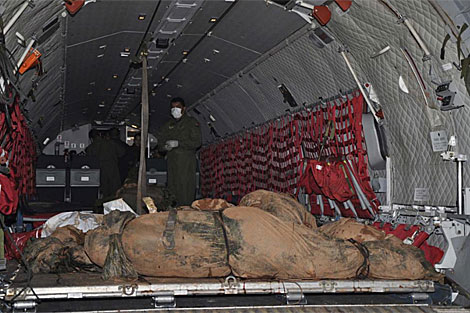They said Operation Sodom, as it has been dubbed, started on Tuesday 21 September, when the heads of all three branches of the Colombian military, the police and the Ministry of Defence met in Bogota to finalise details of the attack.
In the early hours of Wednesday 22 September, 78 aircraft headed for the area known as La Escalera in the Macarena mountain range in Meta province.
They dropped dozens of bombs on Mono Jojoy’s camp, which Defence Minister Rodrigo Rivera has described as “the mother of all lairs” for its size and the number of hidden tunnels it had.
About 400 members of the Colombian special forces then abseiled from helicopters and surrounded the camp.
After hours of fighting, another 400 soldiers and police moved in on the camp, taking it in the early hours of Thursday morning.
*****
What can I say? This is an incredible stroke of luck for the Colombian government in their war against the FARC, and bravo to them for pulling off such an operation.
The first thing that jumped up at me was how they were able to find out who the boot manufacturer was that Mono used to make his custom made jungle boots. Because from that little tip, this entire operation was grown. Basically, once they had a fix on these boots, they were able to slip a GPS tracking device into them and follow the path these boots made from shop to secret jungle camp.
Once the location was found, you can see from the quote up top that the government forces quickly took advantage. They knew what they had, and they put everything they had into being successful.
The use of their Embraer Super Tucanos in this operation is very interesting. With these things, the cost of the air operation is significantly cheaper. This aircraft is also getting a lot of looks from other countries who are fighting insurgencies where their enemies do not have jet aircraft or any serious air power. The reasoning here is that why use multi-million dollar jets that cost thousands of dollars an hour to fuel and maintain, when you can accomplish the same task with cheaper prop aircraft? Colombia is definitely proving the validity of the concept.
The capture of computer hardware is impressive as well. I would suspect that the FARC is sweating bullets right now because everyone on Mono’s hard drive will now be a target. Expect to see more clean up operations designed to demoralize the FARC, and drive them to either dissolve or just surrender. I certainly hope that Colombia is able to break their will and sink this pathetic drug fueled organization. (Mexican drug cartels, you’re next. lol)
Now onto some lessons here. The whole GPS in the boot trick is pretty damn cool and I think any chance we can do the same thing with other enemies in today’s various insurgencies would be a good thing. I say the smaller you can make the device, the better, and make it sturdy enough to insert in all and any objects. Even troops in Afghanistan could be putting GPS devices in all types of things that the enemy could possibly pick up and want to use. These devices should not be just the tools of specialists, and they should be viewed as the tool of modern day combat trackers.
One area that the GPS trick might be well served, is in the endeavor to track animals for anti-poacher operations. Eeben Barlow talked about the Rhino poaching problem in South Africa the other day, and I think small GPS tracking devices would be very helpful in anti-poaching operations.
Better yet, Joseph Kony of the LRA could be tracked using the same method the Colombians used against Mono Jojoy. Either set up some child’s AK with a GPS in the stock, or introduce several of these devices somehow into the possession of this group. Any way possible to track these folks should be looked at and planned for. If you strive to know your enemy, you should be able to find some weakness or opening at one point in your hunt for him. The imagination is the only limit and the pay off would be incredible. –Matt
FARC Military Leader Suárez’s Death Is Blow to Four-Decade Insurgency
Colombian police examine Farc rebels’ laptops
A chip hidden in the boots of Mono Jojoy allowed to locate in the jungle
——————————————————————

The bodies of guerrillas killed, including Mono Jojoy.
Colombia Kills Guerrilla Chief
FARC Military Leader Suárez’s Death Is Blow to Four-Decade Insurgency
By JOSé DE CóRDOBA And DARCY CROWE
BOGOTA—Colombia’s army killed the military leader of the country’s communist guerrillas in a two-day battle that involved airstrikes against his jungle bunker, dealing a major blow to the four-decade insurgency, officials said Thursday.
Victor Suárez, 57 years old, nicknamed “Mono Jojoy,” was the second in command and top field marshal of the Revolutionary Armed Forces of Colombia, or FARC, Latin America’s biggest and oldest guerrilla group. To many ordinary Colombians, his thick moustache and Che Guevara-style black beret were synonymous with the FARC.
“Mono Jojoy is dead,” Colombian President Juan Manuel Santos told reporters in New York, where he is attending the United Nations General Assembly. “This is the most devastating blow ever dealt to the FARC.”
The strike was a big boost for Mr. Santos, who took office in August. He dubbed the military mission, which involved more than 30 aircraft, “Operation Welcome.” In his role as defense minister under Colombia’s previous president, Álvaro Uribe, Mr. Santos oversaw some notable blows against the FARC.